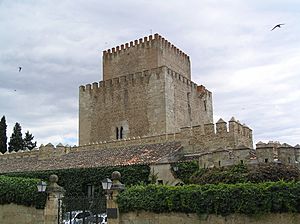Siege of Ciudad Rodrigo (1810) facts for kids
Quick facts for kids Siege of Ciudad Rodrigo |
|||||||
|---|---|---|---|---|---|---|---|
| Part of Peninsular War | |||||||
 Torre del Homenaje del Castillo de Enrique II from the Plaza del Castillo, with a 1507 barrier in the foreground |
|||||||
|
|||||||
| Belligerents | |||||||
| Commanders and leaders | |||||||
| Strength | |||||||
| 42,000 | 5,500 | ||||||
| Casualties and losses | |||||||
| 1,500 | 5,500 | ||||||
The Siege of Ciudad Rodrigo was an important battle during the Peninsular War. This war took place in Spain and Portugal between 1807 and 1814. It was part of the larger Napoleonic Wars across Europe.
In this siege, French forces led by Marshal Michel Ney attacked the fortified city of Ciudad Rodrigo in Spain. The city was defended by Spanish troops under Field Marshal Andrés Pérez de Herrasti. The siege lasted from April 26 to July 10, 1810. The French army, much larger than the Spanish defenders, eventually captured the city. This victory was a key step in France's plan to invade Portugal.
Contents
What Was the Background of the Siege?
The Peninsular War was a conflict where France, led by Napoleon Bonaparte, fought against Spain, Portugal, and Great Britain. Napoleon wanted to control the Iberian Peninsula (Spain and Portugal).
The siege of Ciudad Rodrigo was the start of France's third major invasion of Portugal. The French army aimed to push into Portugal and capture its capital, Lisbon. To do this, they first needed to take Ciudad Rodrigo, a strong Spanish city near the border.
Who Fought in the Siege?
The main forces involved were the French and the Spanish.
French Forces
The French army was very large, with about 42,000 soldiers. They were led by Marshal Michel Ney. His troops were part of an even bigger army of 65,000 men, all under the command of Marshal André Masséna. The French also had many cannons, about 60 of them, to attack the city walls.
Spanish Defenders
The Spanish garrison defending Ciudad Rodrigo had about 5,500 soldiers. Their commander was Field Marshal Andrés Pérez de Herrasti. These defenders included regular army battalions, artillery experts, and engineers. Local volunteers and city guards also joined the fight to protect their home.
How Did the Siege Happen?
The Spanish defenders hoped that British forces, led by Viscount Wellington, would come to help them. However, Wellington's army was much smaller than the French. He decided not to risk a direct battle and waited near the Portuguese border instead.
A Brave Defense
Despite being greatly outnumbered, the Spanish garrison fought bravely for over ten weeks. They refused to surrender even when first asked. They held out for a long time, causing a significant delay for the French invasion plans.
The City Falls
The French used their powerful cannons to break through the city's defenses. They created large holes, called breaches, in the walls. Once the walls were broken, French soldiers were ready to storm the city.
Seeing that further resistance was impossible, Field Marshal Herrasti met with Marshal Ney. Ney offered an honorable surrender, promising that the people and their property in the city would be safe. However, all the Spanish soldiers and leaders who had fought would be taken prisoner to France. Herrasti accepted these terms.
After the Battle
Sadly, after the city surrendered, the French troops did not keep Ney's promise. They looted and pillaged Ciudad Rodrigo.
The Spanish suffered heavy losses, with many killed or wounded. About 4,000 Spanish soldiers and 118 cannons were captured. The French also had casualties, with about 180 killed and over 1,000 wounded.
What Happened After the Siege?
The capture of Ciudad Rodrigo was a French victory, but it came at a cost. The long siege delayed Marshal Masséna's invasion of Portugal by more than a month. This delay turned out to be very important for the British and Portuguese.
Moving Towards Lisbon
After Ciudad Rodrigo, the French continued their advance into Portugal. They fought another battle, the Battle of the Côa, and then began the Siege of Almeida. This siege ended quickly when a huge explosion destroyed the fortress's gunpowder storage. With these obstacles cleared, the French could march towards Lisbon.
The Lines of Torres Vedras
As the French advanced, the British and Portuguese armies retreated. They fell back to a strong defensive position called the Lines of Torres Vedras. These were a series of forts and defenses built to protect Lisbon. The delay caused by the Siege of Ciudad Rodrigo gave the British and Portuguese precious weeks to finish building these lines.
The Lines of Torres Vedras were very successful. They stopped the French invasion and prevented the British from having to leave Portugal. This defense was a major turning point in the Peninsular War. The delay at Ciudad Rodrigo played a big part in the overall Allied victory in the war.
A Second Siege
Interestingly, Ciudad Rodrigo was besieged again in January 1812. This time, the French were the ones defending the city, and they lost it after a much shorter siege of two weeks.
Images for kids
See also
 In Spanish: Sitio de Ciudad Rodrigo (1810) para niños
In Spanish: Sitio de Ciudad Rodrigo (1810) para niños


